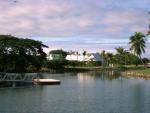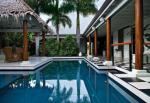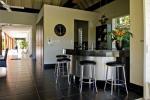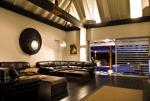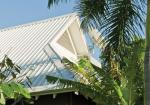Greenville House On Denerau Island
Paula and Ross Greenville operated a very successful boutique accommodation facility adjacent to the golf course in Mount Maunganui for a number of years. This luxury accommodation catered for overseas visitors who were particularly interested in golf.
In 2004 a change in lifestyle was in order. Paula and Ross decided that they would construct a new home for themselves in a warmer location and again, adjacent to a golf course. This was to be located on a site on Denerau Island in Fiji.
The 1,000 square metre sites are located with a street access at one end and a waterway access at the other end. The Greenville site has a view north to a section of the golf course which runs along the opposite side of the waterway. The best of all worlds !
Details of the site and the local planning limitations were forwarded to their Architect friend, Garry Glasgow and a meeting was arranged to discuss the proposal.
Garry had a fair idea of what the Greenville brief would be, and prepared a preliminary scheme for a house prior to the meeting. He later discovered that a requirement which was originally considered to be important was for a short walking distance from the car to the kitchen. This was the one aspect the plan did not achieve. The predominant site planning arrangement existing on Denerau Island generally locates the swimming pool in the yard which is adjacent to the waterway.
Garry argued against this model and proposed that the pool should be located within the building complex to provide a greater degree of privacy and intimacy for the users of the pool. Local building rules do not restrict convenient access to swimming pools, as is the case in New Zealand.
Some of the desirable and important requirements in tropical buildings include:
n Structures with substantial provision for natural ventilation.
n Structures which resist tropical wind forces,
n Structures which cater for tropical rainfall volumes,
The house is designed as a series of three separated rectangular pavilions which surround a central courtyard with swimming pool. The pavilions all contain a single room width to allow for ease of natural cross ventilation.
The pavilion adjacent to the street contains a double garage and a large guest room separated by a two metre wide entrance tunnel. The kitchen, dining and living are located in the pavilion adjacent to the waterway and the pavilion along the west boundary contains three separate bedroom suites.
The three pavilions are linked with a wide verandah which also surrounds the three sides of the swimming pool.
All rooms open to the pool and this allows for a tropical early morning swim to become a very natural and convenient start to any day.
All pavilions have door and window openings on each side of the building to facilitate cross ventilation. The main living pavilion has sets of double sliding doors facing to the central courtyard on one side and facing out to the waterway on the opposite side. There is a folding awning above the doors facing to the waterway.
When the doors are open on both sides of the living pavilion this allows for a view from the swimming pool across the waterway to a tee on the golf course, which does suit the owners very well.
The high roofs and the louvred gable-end aid the building ventilation. It has been found that the natural breezes which are present at any time are channelled through the two metre wide gaps which exist between the pavilions and through the two metre wide entrance tunnel to provide welcome cooling to the central courtyard.
The building complex contains no glass in any of the exterior joinery frames.
Doors and windows are all sliding units, and each contain a set of aluminium louvres in place of the conventional glass. The joinery frames in the bedrooms also contain roll-down mosquito curtains. This allows for the angle of the louvres to be adjusted to suit the occupants requirement for light and ventilation while also preventing access for insects. The bedrooms have been provided with air-conditioning units, but these have been found to be unnecessary for the majority of the year.
A roof material which provides adequate wind strength and protection from the marine atmosphere are important considerations in tropical design. A Colorsteel® metal roof provides these properties and also contributes bracing to the roof planes.
The high rainfall volumes which occur in the tropics make the use of simple roof forms which shed water a natural choice. Gutter blockages caused by leaf fall do not provide a serious problem when all pavilions have Colorsteel roofs with a 45 degree pitch which discharge to gutters which are located at the perimeter of the building.
The structure consists of a reinforced concrete floor slabs and concrete masonry walls, with a timber framed roof structure.
The roof structure is designed to cater for tropical wind pressures with a greater accent on tie down fixings than is the case in New Zealand conditions.
Specifically designed steel brackets connect each rafter to the top of the concrete walls. Patent galvanised steel angle cleats connect every purlin to the rafters.
The screw fixings for the Colorsteel roof are located at every rib on every purlin crossing to ensure a secure fixing.
The owners have constructed several houses in Auckland and in Mount Maunganui. Building in Fiji presents some interesting issues as there is no “building code” as we are accustomed to in New Zealand. ”In fact,” Garry says, “the control on quality is dependant on the insurance companies who insist on engineering reports and architectural qualifications to comply with their building criteria. For this reason more detailed construction supervision was required than is the case within New Zealand. ”
Ross supervised local tradesmen to carry out the construction of this house and after much concentrated work this has resulted in a new house of which they are very proud. Owners, Paula and Ross, have hosted many enjoyable functions around the pool including a recent 60th birthday party.

